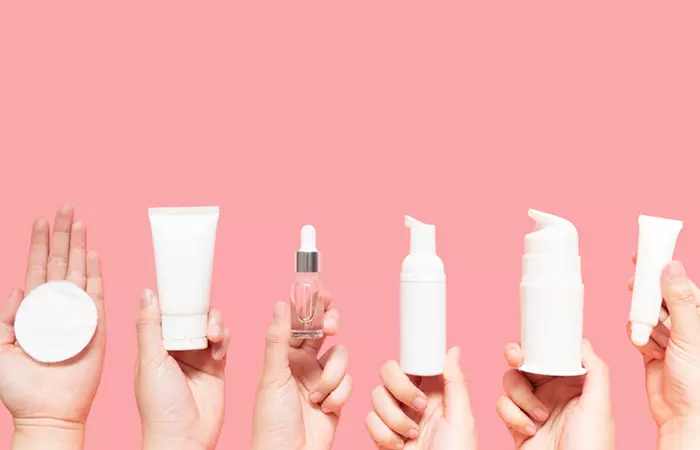What Is Sodium Methyl Cocoyl Taurate?
Sodium methyl cocoyl taurate is a mild surfactant derived from coconut. What Are Its Benefits? Cleanses the skin without drying it, improves product absorption in skin, prevents inflammation, and strengthens the skin barrier. Who Can Use It? Suitable for both adults and children and all skin types. How Often? Can be used daily or as recommended on the product or a dermatologist. Caution It may cause eye irritation and skin rash.
It is white and has a paste-like consistency. It is found in many skin and hair care products like cleansers and shampoos (rinse-off products), including baby products. However, it is also used in leave-on products like foundations and face powders and other products like mouthwashes and breath fresheners (1). According to Dr. Sandra El Hajj, Founder & President of The American Preventive Health Organization, “Sodium methyl cocoyl taurate or SMCT is the best alternative to harsh silicones and is safe for use due to its minimal side effects.” Board-certified dermatologist Dr. Ahmad Chaudhry, MD, says, “ Sodium methyl cocoyl taurate is mild, less potent, and does not alter the skin pH. As a result, it is suitable for people with sensitive skin.” This ingredient has numerous benefits. Let’s take a look.
What Does It Do?
Taurates like sodium methyl cocoyl taurate are mild anionic surfactants. They are commonly used in sulfate-free shampoos to cleanse the scalp without drying as they have a chemically stable pH (2). Sodium methyl cocoyl taurate can enhance the penetration of other ingredients in the skin (1). Taurine surfactants may also exhibit antioxidant properties, regulate inflammatory responses, and enhance the skin barrier function (3). Since it is a non-drying cleanser, it can keep the skin soft and moisturized after use. It is also said to be safe non-irritating, moisturizing, and gentle for sensitive skin.
How Is Sodium Methyl Cocoyl Taurate Made?
SMCT is prepared by dissolving N-methyl taurine (a coconut fatty acid amide) in a blend of sodium hydrate, isopropyl alcohol, and water. A mixture of lauric acid, sodium chloride, and sodium hydrate is added to the solution. A solution of calcium chloride and hydrochloric acid is added to the blend.
The mixture is then refined, strained, and dried, forming a whitish powdery substance. It can also be found as a solution mixed with water and sodium chloride (1).
In this method, coconut fatty acid amide – N-methyl taurine, sodium methyl taurate solution, and boric acid are heated at 200° C. It is then distilled in water and stirred at lower heat and pressure levels. The mixture is cooled down to form a wax-like substance that is powdered.
Sodium methyl cocoyl taurate is added to almost all skin care and hair care products. Here are some of the products you can find this mild surfactant in.
What Products Is It Commonly Found In?
Face washes Low pH anti-acne products Shampoos Body washes Face masks Toothpastes Liquid soaps
Bubble bath soaps Skin creams Skin lotions Baby care products Oral products
This mild surfactant is used in different concentrations, based on the product formulation. But how much of it can be used in skin care products? Let us find out.
Safe Concentration In Skin Care Products
According to the Cosmetics Ingredient Review (CIR), sodium methyl cocoyl taurate (SMCT) is safe for use at concentrations of up to 10%. The CIR conducted various tests to conclude that SMCT showed negative results in terms of skin irritation, thereby marking it safe for use in cosmetics that have a non-irritating formula (5). It is often used at a concentration of 13% in rinse-off foot products and is reportedly used at concentrations of up to 1% in products that may be sprayed. For direct application products, such as face powders, it is present at concentrations of up to 6% and up to 11% in leave-in products. Although sodium methyl cocoyl taurate is mostly considered safe, it may cause adverse reactions.
Is It Safe For The Skin?
Sodium methyl cocoyl taurate may cause (1):
Redness and skin rash (erythema) Eye irritation
Hence, always do a patch test before using products with sodium methyl cocoyl taurate. Is sodium methyl cocoyl taurate safe during pregnancy? There is not much information or research available about using sodium methyl cocoyl taurate when pregnant or breastfeeding. Even though sodium methyl cocoyl taurate is generally thought to be safe, it can induce adverse effects. To avoid these reactions, perform a patch test. Is sodium methyl cocoyl taurate the same as SLS? No. Sodium methyl cocoyl taurate is a prominent substitute that is used by companies for SLS. It is a gentle, long-lasting surfactant with excellent foaming properties but no irritating properties. What is the other name for sodium methyl cocoyl taurate? The other names for sodium methyl cocoyl taurate are sodium formyl taurine and sodium methyl cocoyl taurine. Is sodium methyl cocoyl taurate safe for fungal acne? No, anecdotal evidence suggests that sodium methyl cocoyl taurate is not safe for fungal acne as it contains fatty acids that may trigger it. However, there are no relevant studies to support this claim. Is sodium methyl cocoyl taurate vegan and cruelty-free? Yes, sodium methyl cocoyl taurate is vegan and cruelty-free as it is made from all-natural plant-based ingredients like coconut. Also, no animals are known to be harmed in its making.








